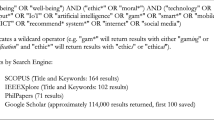Abstract
Having reviewed a considerable body of scholarly work in neuroethics related to DBS, Gilbert, Viaña, and Ineichen identify a major flaw in the debate—a “bubble” in the literature—and propose new directions for research. This comment addresses the authors’ diagnosis: What exactly is the nature of this bubble? Here, I argue that there are at least two different orientations in the “DBS causes personality changes” bubble. According to a first narrative, DBS is a special technology because its direct, causal action on the brain leads to personality changes. This approach emphasizes the brain as the seat of personality, the locus of identity, or the center of agency. According to a second narrative, technology in general plays a major role in our lives and in our experiences as human subjects, and DBS is no exception. Technology matters up to the point that it reshapes, redefines, or re-determines traditional concepts such as personality, authenticity, or agency. I point out that both narratives are distinct components of the “DBS causes personality changes” bubble diagnosed by the authors of the target article and claim that the two narratives raise somehow different philosophical and empirical issues.
Similar content being viewed by others
References
Gilbert, F., J.N.M. Viaña, and C. Ineichen. 2018. Deflating the ‘DBS causes personality changes’ bubble. Neuroethics. https://doi.org/10.1007/s12152-018-9373-8.
Gisquet, E. 2008. Cerebral implants and Parkinson’s disease: A unique form of biographical disruption? Social Science & Medicine 67: 1847–1851. https://doi.org/10.1016/j.socscimed.2008.09.026.
Roskies, A. 2002. Neuroethics for the new Millenium. Neuron 35 (1): 21–23. https://doi.org/10.1016/S0896-6273(02)00763-8.
Marcus, S. 2002. Neuroethics: Mapping the field. San Francisco: Dana Foundation.
Levy, N. 2007. Neuroethics, challenges for the 21st century. Cambridge: Cambridge University Press.
Glannon, W. 2011. Brain, body, and mind: Neuroethics with a human face. New York: Oxford University Press.
Vidal F., and M. Piperberg. 2017. Born free: The theory and practice of neuroethical exceptionalism. In Debates About Neuroethics, ed. E. Racine and J. Aspler, 67–81. Cham: Springer International Publishing AG.
Vidal, F. 2018. What makes neuroethics possible? History of the Human Sciences.: 095269511880041. https://doi.org/10.1177/0952695118800410.
Bury, M. 1982. Chronic illness as biographical disruption. Sociology of Health and Illness 4 (2): 167–182. https://doi.org/10.1111/1467-9566.ep11339939.
Carel, H. 2008. Illness: The cry of the flesh. Stocksfield: Acumen.
Gilbert, F., E. Goddard, J.N.M. Viaña, A. Carter, and M. Horne. 2017. I miss being me: Phenomenological effects of deep brain stimulation. AJOB Neuroscience 8 (2): 96–109. https://doi.org/10.1080/21507740.2017.1320319.
Agid, Y., et al. 2006. Neurosurgery in Parkinson’s disease: The doctor is happy, the patient less so? Journal of Neural Transmission Supplement 70: 409–414. https://doi.org/10.1007/978-3-211-45295-0_61.
Schüpbach, M., et al. 2006. Neurosurgery in Parkinson disease: A distressed mind in a repaired body? Neurology 66 (12): 1811–1816. https://doi.org/10.1212/01.wnl.0000234880.51322.16.
Turkle, S. 2011. Alone together. Why we expect more from technology and less from each other. New York: Basic Books.
Latour, B. 1999. Pandora’s Hope. Cambridge: Harvard University Press.
Latour, B. 2002. Morality and technology. Theory Culture & Society 19 (5–6): 247–260. https://doi.org/10.1177/026327602761899246.
Verbeek, P.-P. 2008. Obstetric ultrasound and the technological mediation of morality: A Postphenomenological analysis. Human Studies 31 (1): 11–26. https://doi.org/10.1007/s10746-007-9079-0.
Dubiel, H. 2006. Deep in the brain. Living with Parkinson’s disease. New York: Europa editions.
Ambermoon, P., A. Carter, W.D. Hall, N.N.W. Dissanayaka, and J.D. O’Sullivan. 2011. Impulse control disorders in patients with Parkinson’s disease receiving dopamine replacement therapy: Evidence and implications for the addictions field. Addiction 106 (2): 283–293. https://doi.org/10.1111/j.1360-0443.2010.03218.x.
Kim, Y., et al. 2013. Impulse control and related behaviors after bilateral subthalamic stimulation in patients with Parkinson’s disease. Journal of Clinical Neuroscience: Official Journal of the Neurosurgical Society of Australasia 20 (7): 964–969. https://doi.org/10.1016/j.jocn.2012.07.020.
Merola, A., A. Romagnolo, L. Rizzi, M.G. Rizzone, M. Zibetti, M. Lanotte, G. Mandybur, A.P. Duker, A.J. Espay, and L. Lopiano. 2017. Impulse control behaviors and subthalamic deep brain stimulation in Parkinson disease. Journal of Neurology 264 (1): 40–48. https://doi.org/10.1007/s00415-016-8314-x.
Acknowledgements
I thank the organizers and participants of the panel What are the relationships between STS and empirical ethics? (4S 2018 Sydney) and Frédéric Gilbert.
Author information
Authors and Affiliations
Corresponding author
Additional information
Publisher’s Note
Springer Nature remains neutral with regard to jurisdictional claims in published maps and institutional affiliations.
Rights and permissions
About this article
Cite this article
Gaillard, M. Neuroessentialism, our Technological Future, and DBS Bubbles. Neuroethics 14 (Suppl 1), 39–45 (2021). https://doi.org/10.1007/s12152-019-09407-6
Received:
Accepted:
Published:
Issue Date:
DOI: https://doi.org/10.1007/s12152-019-09407-6




